Improving watershed health with natural burial
By Michael Ahr and Holly Pruett, March 27 2016
 When Henry Corbett, William Ladd and Henry Failing purchased 350 acres along the west bank of the Willamette River in 1879 to create a nonprofit cemetery, they surely never imagined what would end up in the ground and overrunning its ravines 100 years later.
When Henry Corbett, William Ladd and Henry Failing purchased 350 acres along the west bank of the Willamette River in 1879 to create a nonprofit cemetery, they surely never imagined what would end up in the ground and overrunning its ravines 100 years later.
“From its beginnings, River View Cemetery was seen as a major milestone in Portland’s development; a beautiful, serene, well‐designed and maintained final resting place for the city’s dead,” according to historian George Kramer. “Its graceful, almost park‐like, natural setting quickly became a popular recreational destination for Portlanders, complementing the project’s primary purpose.”
Since then, nationwide changes in funeral industry practices have dictated the use of materials guaranteed to prevent the natural cycle of “ashes to ashes, dust to dust.” Concrete burial liners, imported hardwood and metal caskets, and bodies preserved with embalming fluid replaced the simple pine boxes used by Portland’s founding fathers. Above ground, the rampant spread of invasive species choked the streams flowing through the property and caused trees to die off, their canopies covered by weeds.
 Today, thanks to consumer demand, progressive cemetery management, and a partnership with West Multnomah Soil & Water Conservation District, River View Cemetery is becoming known as one of the country’s leading natural burial grounds, serving as guardian of the community’s heritage, history and environment.
Today, thanks to consumer demand, progressive cemetery management, and a partnership with West Multnomah Soil & Water Conservation District, River View Cemetery is becoming known as one of the country’s leading natural burial grounds, serving as guardian of the community’s heritage, history and environment.
Natural burial in the heart of the city
In recent years, ecologically-minded consumers have started to look for greener options than cremation (with its emissions and appetite for fossil fuels) and conventional burial. The green burial movement champions the form of natural burial that was once standard practice: earth burial without chemical embalming, in a biodegradable casket or a simple shroud.
Unlike some cemeteries that only allow natural burial in one segregated section of the cemetery, in 2009 River View Cemetery become one of the first cemeteries in the nation to allow natural burial in nearly every area of the cemetery. That means a person can be buried in a family plot without the requirements imposed by most other cemeteries for embalming or a concrete outer burial vault.
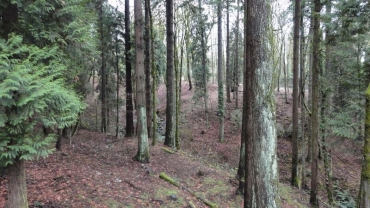 In the coming years, River View plans to open a new section of the cemetery as a dedicated natural burial area, landscaped with only native plants, free from harmful chemicals and pesticides. And in the future, the cemetery expects to make natural burial available in its forested acres.
In the coming years, River View plans to open a new section of the cemetery as a dedicated natural burial area, landscaped with only native plants, free from harmful chemicals and pesticides. And in the future, the cemetery expects to make natural burial available in its forested acres.
A mecca for people and wildlife
River View Cemetery is a popular place for bicycle commuters (on designated routes) and anyone who enjoys views of Mt. Hood, a glimpse of the resident bald eagles, and an arboretum-like setting filled with human and natural history. River View’s 170 acres include nearly 70 acres of forest bordering streams in deep ravines cutting through the cemetery grounds. Deer are a regular sight, and dozens of other species of mammals, amphibians and birds typically reside in this type of habitat.
Beyond the habitat provided, the cemetery occupies an important niche in the larger watershed. The Stephens Subwatershed Improvement Strategies Report (2009), published by Portland's Bureau of Environmental Services, found that watershed function and habitat value of the core areas, including the cemetery, are currently degraded by abundant invasive species that crowd out native plants, threatening biodiversity. Damage to the buffer canopy and associated vegetation can lead to higher temperatures in these streams, which are an important source of cool water feeding the Willamette River.
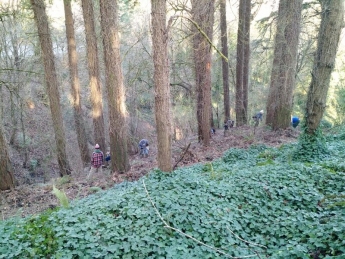 With more than a quarter of River View Cemetery burial clients now opting for natural burial, their choices will help improve the health of this important watershed.
With more than a quarter of River View Cemetery burial clients now opting for natural burial, their choices will help improve the health of this important watershed.
Partnership with WMSWCD
Neighboring Lewis & Clark College and the River View Natural Area managed by the City of Portland have both adopted aggressive invasive weed-removal programs. River View Cemetery has stepped up, too. In 2012, the cemetery began a multi-year project with West Multnomah Soil & Water Conservation District to restore over 14 acres of forested land covered with blackberry, English ivy, holly, laurel and “traveler’s joy."
West Multnomah Soil & Water Conservation District is pleased to assist River View in its stewardship of this important natural area. Controlling invasive weeds in the cemetery’s ravines promotes the growth of native fish, plant species and wildlife throughout the watershed.
Dear Nature, Thank You
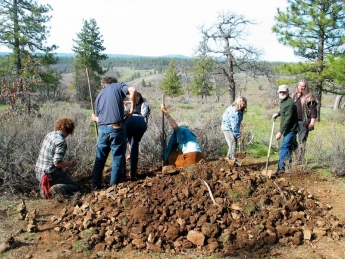 As documented in the film "A Will for the Woods," natural burial is a way for us to practice our environmental values even in death. River View Cemetery, a supporter of the documentary, will show the film in partnership with White Eagle Memorial Preserve, a conservation burial ground in Goldendale, Washington, on April 9 and April 29 as part of two symposiums on natural death care.
As documented in the film "A Will for the Woods," natural burial is a way for us to practice our environmental values even in death. River View Cemetery, a supporter of the documentary, will show the film in partnership with White Eagle Memorial Preserve, a conservation burial ground in Goldendale, Washington, on April 9 and April 29 as part of two symposiums on natural death care.
Portland hospice chaplain Don Tarbutton, who has arranged for his eventual burial at River View, echoes the sentiments of those profiled in the film. “The values I’ve been accumulating over the past decade," he says, "opened me to more participatory forms of end-of-life care and celebration – and natural burial became the obvious end point.”
Celebrate Earth Day at Portland’s eco-friendly cemetery
Two of the region’s only Green Burial Council-certified cemeteries are teaming up to offer a day of learning and conversation. Presented at the historic nonprofit River View Cemetery on Saturday, April 9, and in the Columbia Gorge on Saturday, April 29-30, the Earth Day Natural Death Care Symposium offers three workshops, site tours and the award-winning green burial documentary "A Will for the Woods."
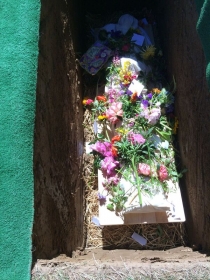 Workshops will cover:
Workshops will cover:
- Natural Burial: Why, How, Where – led by David Noble, executive director of River View Cemetery
- Home Funerals, DIY Memorials & Other Rituals of Remembrance – led by Holly Pruett, life-cycle celebrant & home funeral guide
- Creating a Death Plan & Planning for a Natural Burial – led by Jodie Buller, cemetery manager for White Eagle Memorial Preserve
Join us on April 9 to see the watershed restoration work in person, and to connect with others who want their deaths to reflect the environmental values they’ve practiced in life. Register for all or part of the day’s events here.

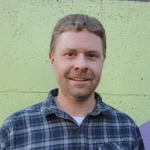
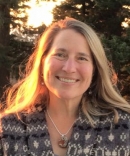 As a forest conservationist at West Multnomah Soil & Water Conservation District, Michael Ahr assists woodland owners in developing and implementing restoration and management plans for their properties. Holly Pruett is a natural burial advocate and life-cycle celebrant, working with families and communities to create unique, personalized celebrations of life’s milestones. Visit her website
As a forest conservationist at West Multnomah Soil & Water Conservation District, Michael Ahr assists woodland owners in developing and implementing restoration and management plans for their properties. Holly Pruett is a natural burial advocate and life-cycle celebrant, working with families and communities to create unique, personalized celebrations of life’s milestones. Visit her website
Add new comment